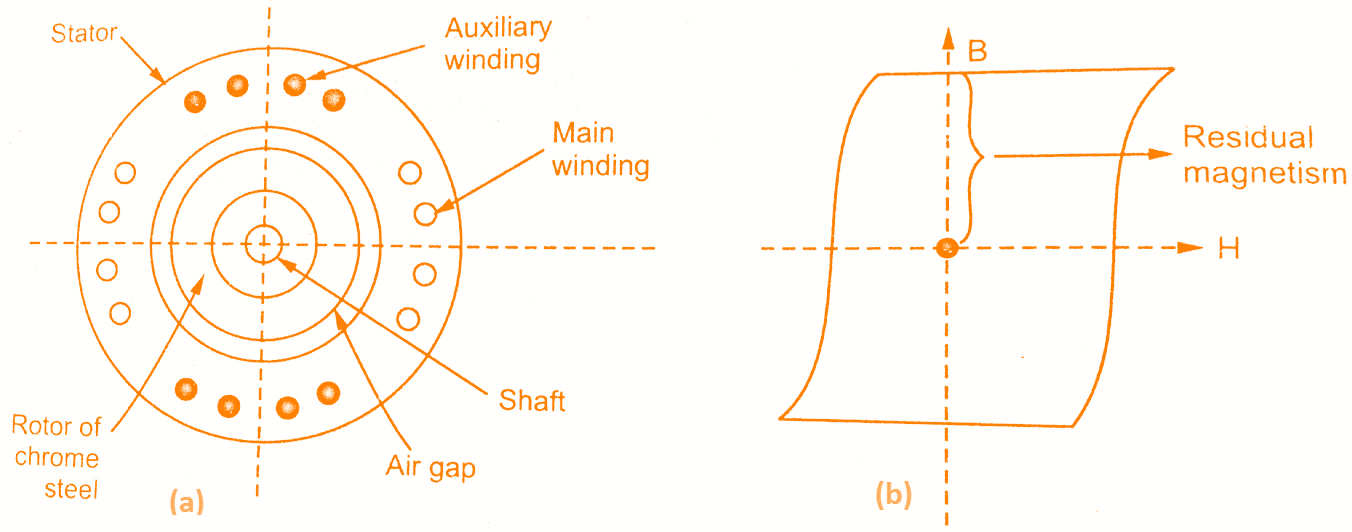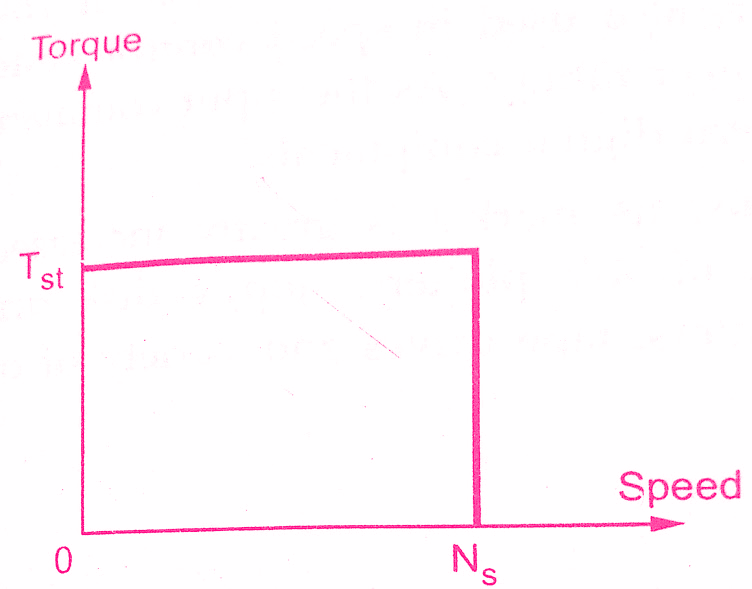What is Hysteresis Motor?
Hysteresis Motor is a synchronous motor with a cylindrical rotor and does not require any dc excitation to the rotor and it uses non-projected poles.It is a single phase motor with rotor made up of ferromagnetic material.
Construction of Hysteresis Motor:
Hysteresis Motor consists of
(i)Stator
(ii)Rotor
(iii)Main windings
(iv)Auxiliary windings
(v)Shaft
(i)Stator:
The stator is wounded with main and auxiliary windings so as to produce rotating magnetic field.In some hysteresis motor designs, the stator can also be shaded pole type.To develop synchronising revolving field from single phase supply, the stator of hysteresis motor is designed accordingly.
Must Read:
(ii)Rotor:
The rotor is smooth cylindrical type made up of hard magnetic material like chrome steel or alnico for high retentivity. This requires selecting a material with high hysteresis loop area.The rotor does not carry any winding or teeth.The rotor of hysteresis motor has high resistance to reduce eddy current loss.This cylindrical rotor is mounted on the shaft through arbour made up of aluminium.
The construction of hysteresis motor is shown in the figure(a) below while nature of hysteresis loop required for rotor material is shown in the below figure(b).
 |
| Construction of hysteresis motor & hysteresis loop for rotor |
What is the Working Principle of Hysteresis Motor?
Initially, when hysteresis motor is started it behaves as a single phase induction motor and while running it behaves as a synchronous motor.When stator is energised with single phase AC supply it produces rotating magnetic field.The main and auxiliary, both the windings must be supplied continuously at the start as well as in running condition so as to maintain the rotating magnetic field.This field induces poles in the rotor.
The hysteresis phenomenon is dominant for the rotor material chosen and due to which rotor pole axis lag behind the axis of rotating magnetic field. Due to this, rotor poles get attracted towards the moving stator field poles.Thus rotor gets subjected to torque called hysteresis torque.This torque is constant at all speeds.When the stator field axis moves forward, due to high retentivity the rotor pole strength remains maintained.So higher the retentivity, higher is the hysteresis torque.
Initially, rotor starts rotating due to the combined effect of hysteresis torque as well as torque due to eddy currents induced in the rotor. Once the speed is near about the synchronous, the stator pulls rotor into synchronism. In such case, as relative motion between stator field and rotor vanishes, so the torque due to eddy currents vanishes.Only hysteresis torque is present which keeps rotor running at synchronous speed. The high retentivity ensures the continuous magnetic locking between stator and rotor.Due to the principle of magnetic locking, the Hysteresis Motor either rotates at synchronous speed or not at all.
Hysteresis Torque Equation in the Hysteresis Motor:
The eddy current loss in the machines is given by
Pe = Kef²2B²
where Ke = eddy current constant
f2 = frequency of eddy currents
B = flux density
We know the relation between rotor frequency f2 and supply frequency f1
f2 = sf1
where S = slip
Pe = KeS²f²1B²
The torque due to eddy currents is given by
So when the rotor rotates at synchronous speed, the slip becomes zero and torque due to eddy current component vanishes.It only helps at the start.The hysteresis power loss is given by,
Key Point: Thus the hysteresis torque component at all the rotor speeds.
Hysteresis Power Loss(Ph) in Hysteresis Motor:
Hysteresis power loss in rotor is given by
where f1 = supply frequency
f2 = frequency of eddy currents
B = flux density
Kh = hysteresis constant
S = slip
Torque Speed characteristics of Hysteresis Motor:
 |
| Torque-speed characteristics of hysteresis motor |
The starting torque and running torque is almost equal in this Hysteresis Motor.As stator carries mainly the two windings its direction can be reversed by interchanging the terminals of either main winding or auxiliary winding.The torque speed characteristics of hysteresis motor are as shown in the figure as seen from the characteristics torque at the start is almost same throughout the operation of the Hysteresis Motor.
Must Read:
Advantages of using Hysteresis Motors:
The advantages of Hysteresis Motor are
- As rotor has no teeth, no winding, there are no mechanical vibrations
- Due to the absence of vibrations, the operation is quiet and noiseless
- Suitability to accelerate high inertia loads
- Possibility of multispeed operation by employing gear train.
Disadvantages of using Hysteresis Motors:
The disadvantages of Hysteresis Motor are
- Low efficiency
- Low torque
- Low power factor
- Available in very small size
- Poor output
Applications of Hysteresis Motor:
Due to the noiseless operation, Hysteresis motor is used in
- Sound recording instruments
- Sound producing equipment
- High-quality record players
- Tape recorders
- Electric Clocks
- Teleprinters
- Timing devices
Conclusion:
Now here we have learnt construction and Working principle of Hysteresis Motor and its applications.You can download this article as pdf, ppt.If you have queries, then you can email us @ palakalaamarnath@gmail.com


